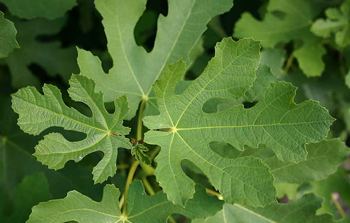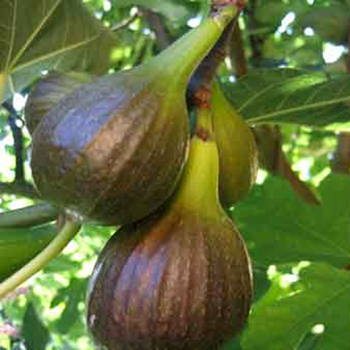Contents:
Common Names | Parts Usually Used | Plant(s) & Culture | Where Found | Medicinal Properties
Legends, Myths and Stories | Uses | Nutrient Content | How Sold | Bibliography
Scientific Names

- Ficus carica L.
- Mulberry family
Common Names
- A-tsang
- Common fig
- Ying-jeh-kuo
- Yu-t’an-po
- Wu-hua-kuo
Parts Usually Used
Fruit
Back to Top
Description of Plant(s) and Culture

The fig tree is a deciduous tree; its wood is soft, and with its many branches it reaches a height of up to 30 feet. The alternate, long-petioled leaves are usually deeply 3-5 lobed and are broad-ovate to nearly orbicular in outline. The thick, palmately ribbed leaf blade is rough on top and finely hairy underneath. The genus ficus is unique in bearing its flowers inside a nearly closed receptacle or branch which ripens into the finely, pear-shaped fruit we call the fig (it is technically called a synconium). The receptacle usually contains both male and female flowers, the male at one end of an internal cavity, the female at the other end. Pollination is accomplished by specialized insects which crawl inside through a small opening at the top. Ripe figs vary in color from greenish-yellow to purple, depending on the variety.
Back to Top
Where Found
Native of the Mediterranean region and is cultivated elsewhere for its fruit.
Back to Top
Medicinal Properties
Demulcent, emollient, laxative
Back to Top
Legends, Myths and Stories
From the Far East to Africa and the Mediterranean, the fig was an important food and a sacred tree to many ancient peoples. The tree is still sacred in India, China, and Japan because under it the monk Gautama received his divine illumination and thus became the Buddha. The Moslems call the fig the “Tree of Heaven” and revere it because Mohammed swore by it. And the fig played a significant part in the life of the early Hebrew people, as many biblical references show. The discovery of a fig-harvesting scene on the wall of an Egyptian tomb dated about 1900 to 1700 BC indicates that the fruit was also important to the ancient Egyptians. Sacred to the Greeks and Romans, the fig was said to be a gift to the people from the Greek god of wine and agriculture, Dionysus, the fig was included along with the phallus as a fertility symbol. This association is the origin of its sexual symbolism, which survives even today in certain vulgar expressions and gestures.
The fig tree also had a part in the founding of Rome. According to legend, Rome was built at the spot where a fig tree caught Romulus and Remus as they floated down the river Tiber in a basket.
The ancients claimed that if you tied a mad bull to a fig tree he would quickly become tame and gentle. Also, the claim is that, like the bay tree, the fig tree is never hurt by lightning.
Back to Top
Uses
For internal use, the fig has mildly laxative properties and is often used in combination with senna and carminative herbs. A decoction of figs acts to soothe the mucous membranes of the respiratory passages when you have a cold. The fresh fig, roasted and cut in half, makes a good emollient poultice for boils and small tumors. The stems and leaves contain an acrid milky juice that can be used to remove warts. Figs are also used to make wine. Externally, the leaves were considered a remedy for leprosy, sores, ulcers, scabs, bruises, dog bites, dropsy, and epilepsy.
Back to Top
Nutrient Content
Fats, carbohydrates, iron, potassium, and magnesium
Back to Top
How Sold
Figs are found in the produce section of the supermarket
Back to Top
Bibliography
![]() American Folk Medicine
American Folk Medicine, by Clarence Meyer, Meyerbooks, publisher, PO Box 427, Glenwood, Illinois 60425, 1973
![]() Back to Eden
Back to Eden, by Jethro Kloss; Back to Eden Publishing Co., Loma Linda, CA 92354, Original copyright 1939, revised edition 1994
![]() Chinese Medicinal Herbs
Chinese Medicinal Herbs, compiled by Shih-Chen Li, Georgetown Press, San Francisco, California, 1973.
![]() The Complete Medicinal Herbal
The Complete Medicinal Herbal, by Penelope Ody, Dorling Kindersley, Inc, 232 Madison Avenue, New York, NY 10016, First American Edition, copyright 1993
![]() Culpeper’s Complete Herbal & English Physician: Updated With 117 Modern Herbs
Culpeper’s Complete Herbal & English Physician: Updated With 117 Modern Herbs, by Nicholas Culpeper, Meyerbooks, publisher, PO Box 427, Glenwood, Illinois 60425, 1990, (reprint of 1814)
![]() The Herb Book
The Herb Book, by John Lust, Bantam Books, 666 Fifth Avenue, New York, NY. copyright 1974.
![]() The Nature Doctor: A Manual of Traditional and Complementary Medicine
The Nature Doctor: A Manual of Traditional and Complementary Medicine, by Dr. H.C.A. Vogel; Keats Publishing, Inc., 27 Pine Street (Box 876) New Canaan, CT. 06840-0876. Copyright Verlag A. Vogel, Teufen (AR) Switzerland 1952, 1991
![]() Webster’s New World Dictionary
Webster’s New World Dictionary, Third College Edition, Victoria Neufeldt, Editor in Chief, New World Dictionaries: A Division of Simon & Schuster, Inc., 15 Columbus Circle, New York, NY 10023
